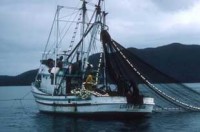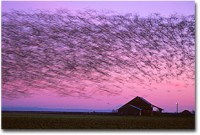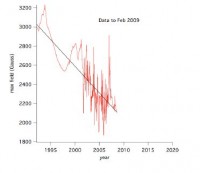By Steve McIntyre, Climate Audit
As CA readers know, Phil Jones keeps his CRU data secret. Embarrassingly, the UK Met Office relies on this secret data and says that it is unable to provide this supporting data for the most relied upon temperature data set in the world. Their statements in response to FOI requests as to what they actually hold seem contradictory, but most recently they state that they do not hold original data, but only the “value added version” provided to them by Phil Jones. Whether they are entitled to keep the “value added version” secret is something that their FOI officer is presently considering. Recently, Anthony Watts discovered that the Honolulu Observatory data, which NOAA and NASA lost track of in the 1980s, continued to the present day. Anthony observed the substantial difference between trends at Honolulu airport and at more rural sites.
When I’ve done previous benchmarking of GISS data, I’ve usually tried to use relatively isolated stations so that the effect of data inclusions and exclusions could be simplified. Since Hawaii is relatively isolated, it seemed like it would be an interesting exercise to look at the Hawaiian gridcell, to get a preview of whether the “discovery” of a long data set might have an impact at the gridded level.
As so often, when one goes down a climate science rabbit hole, wonderland awaits. First, here’s a graphic showing an interesting contrast between the CRUTEM gridded data and the NOAA/GHCN gridded data for the Hawaii gridcell (157.5W, 22.5N). In one of his FOI obstructions, Phil Jones argued that CRUTEM data was already available at GHCN. But as you see, the CRUTEM gridded version for the Hawaii gridcell is remarkably different from the NOAA GHCN version.

To illustrate the stunning difference between the two series, here’s a plot of the difference. CRU has increased relative to GHCN by approximately 2 deg C during the 20th century. ([snark] I guess that’s what the Met Office means by the “value added” product/ [/snark])

Reconciling these sorts of differences is quite time consuming and one would think that this would be the sort of thing that the temperature index providers would spend time doing. But unfortunately they seem to use funding for temperature indices to support other activities that they enjoy more and spend negligible time on QC - Gavin Schmidt justified the lack of QC on the basis that is unreasonable to expect NASA to be able to keep track of such things as they only allocate about 0.25 man-years annually to quality control. Read more here.
By Marc Sheppard, American Thinker
Surely climate alarmists enjoy enough unfair advantage over their rational counterparts, what with the mainstream media shamelessly suppressing the findings of the latter for political purposes. But now there’s compelling evidence that alarmists within our government have also taken unfair advantage, suppressing the results of their own climate study for the same nefarious reasons.
Sixty days ago yesterday, EPA chief Lisa Jackson released the Proposed Endangerment and Cause or Contribute Findings for Greenhouse Gases under Section 202(a) of the Clean Air Act. The proposal initiated a statutory period of public commentary - ending yesterday - providing a forum to experts and interested parties on both sides of the “CO2 as pollutant” issue prior to any regulatory action.
But on the final day of the public commentary period, a dispatch was submitted to the EPA accusing them of attempting to cover-up an internal study that imperiled the outcome predetermined by both the agency and its puppeteers - the Obama administration. And the intraagency emails attached to the letter—submitted by Competitive Enterprise Institute (CEI) general counsel Sam Kazman [PDF]—leave little room for doubt.
One EPA office director actually demanded that the endangerment-challenging study be barred from circulation within the agency, never disclosed to the public, and not placed in the docket of the proceeding. And, as Kazman observed dead-on, the communications between that EPA National Center for Environmental Economics (NCEE) Office Director—Al McGartland—and study author Alan Carlin, an NCEE Senior Operations Research Analyst, made clear that it was the study’ conclusions rather than its merit that earned it its place on the trash heap.
In a March 16 email to McGartland (who in a prior email had forbade his speaking to anyone outside NCEE on endangerment issues) and three other NCEE staffers, Carlin requested that his study be forwarded to EPA’s Office of Air and Radiation (OAR), which directs EPA’s climate change program. Carlin pointed out that roughly two-thirds of his references were from peer-reviewed publications and that his comments “explain much of the observational data that have been collected which cannot be explained by the IPCC models.”
The next day, Carlin received two emails from McGartland. The first announced the director’s decision not to forward Carlin’s comments to OAR, explaining that he could “only see one impact of your comments given where we are in the process, and that would be a very negative impact on our office.” The second was a direct order arriving eight minutes later: “I don’t want you to spend any additional EPA time on climate change.”
Now that’s democratic public commentary at work. Can’t imagine why the term bureaucrat is more often than not slung pejoratively. In all likelihood, the threat of CO2 regulation is merely an Administration ruse to coerce legislation. And Waxman-Markey is short on votes, even with proponents in both Houses pushing their skeptical colleagues to capitulate rather than ordain the EPA as the most powerful agency in the country. Remove that specter and remove with it the cap-and-trader’s ace-in-the-hole. Both at home and in Copenhagen in December.
Writes Kazman:
“CEI hereby requests that EPA make this study public, place it into the docket, and either extend or reopen the comment period to allow public response to this new study. We also request that EPA publicly declare that it will engage in no reprisals against the author of the study, who has worked at EPA for over 35 years.”
The attorney reminded the agency of Obama’s April 27th speech to the National Academy of Sciences, in which he declared that “under my administration, the days of science taking a back seat to ideology are over.” He might have also mentioned that during her confirmation hearings in January, Lisa Jackson assured the Senate Environment and Public Works Committee, “If I am confirmed, I will administer with science as my guide,” adding that “political appointees will not compromise the integrity of EPA’s technical experts to advance particular regulatory outcomes.”
At the time, we mocked the glaring absurdity of both oaths. Now we denounce their impudence. And their own mockery of process. Read full post here. Icecap Note: The Competitive Enterprise Institute is today making public an internal study on climate science which was suppressed by the Environmental Protection Agency. Internal EPA email messages, released by CEI earlier in the week, indicate that the report was kept under wraps and its author silenced because of pressure to support the Administrationís agenda of regulating carbon dioxide.
See this New York Times report on this EPA suppression of internal dissention, described this way “What’s happening here is that the EPA is cooking the books,” said Rep. Jim Sensenbrenner (R-Wis.), ranking member of the House Select Committee on Energy and Global Waming. They have suppressed a study that completely blows apart the scientific underpinnings of the endangerment finding that the EPA administrator made on CO2, and this study has been suppressed because it does not fit the Obama administration’s political objectives.” Rep. Joe Barton (R-Texas), ranking member of the Energy and Commerce Committee, said EPA’s actions raise serious questions about the development of the endangerment proposal, “a finding that relates directly to the rush to vote” today on a sweeping climate and energy bill.
The chance of an early election based on climate change appears to have faded for the time being after the Senate delayed a vote on emissions trading.
In the last week of Parliament before the long winter break, senators voted to consider other Bills ahead of the emissions trading scheme legislation.
That means a vote on emissions trading is unlikely this week. It probably will not take place until August, which would kill off the chances of the Government getting the first stage of a double dissolution election trigger before the break. In order to get a double dissolution trigger, the Government must fail to pass the same Bill twice, with a gap of three months between the two votes.
Nonetheless, the emissions trading scheme, due to get under way in 2011, appears doomed to fail in the Senate because no one likes it but Labor. The Coalition teamed with two crossbench senators to push back the vote on the scheme today. Climate Change Minister Penny Wong accused the Opposition of “playing political games’’. “They have been filibustering, wasting time, using every tactic they can to delay debate on this Bill,’’ Senator Wong said.
It would now be “very difficult’’ to find the time to debate the Bill this week. Senator Wong urged the Opposition to allow for extended sittings of the Senate this week to get through all the Bills. Coalition Senate Leader Nick Minchin said it was fair enough to push back debate on the scheme because it did not start for two years.
More pressing Bills, such as those related to an increase in the aged pension and the pension age, as well as the OzCar scheme, should be debated first, he said. ‘’(The Government) are not prioritising their legislation properly,’’ Senator Minchin said.
Greens leader Bob Brown sided with the Government, saying it was time to vote on the emissions trading scheme. The Senate will now debate nine Bills before it gets to laws relating to the scheme. The chamber is due to rise on Thursday evening, but senators may allow debate late into the night and into Friday. Independent senator Nick Xenophon has indicated he may seek to have further modelling undertaken on tackling climate change. He wants to canvass alternative schemes to the emissions trading scheme, and the impact of more ambitious targets to reduce greenhouse gas emissions.
The Opposition says it will not pass an emissions trading scheme this year, but it is not clear if it will do so next year. The success of the leadership of Malcolm Turnbull is pivotal - he is one of the Coalition’s strongest supporters of emissions trading. The Government is struggling to get its climate change plan off the ground. A vote on a scheme to hugely boost renewable energy has also been delayed. See story here.
A victory, albeit at least a temporary one for the good guys and the Australian people. Let’s hope we have the same results here in the United States where congress is considering the Waxman-Markey Cap-and-Tax bill.
By Craig Medred, Anchorage Daily News
A second straight year of weak king salmon returns around the rim of the Gulf of Alaska has state fisheries biologists wondering if they might be staring into the face of a bleak future. Troubling discussions of PDO—an acronym for something called the Pacific Decadal Oscillation—have been spreading coast-wide as kings come back weak in river after river. Historically, there are indications that geographically widespread weaknesses like these are tied to a shift, or oscillation, in Pacific Ocean currents that causes cooler waters to pool in the Gulf of Alaska.
A cool phase in the Gulf from 1947 to 1976 corresponds neatly with the last big crash in king numbers in Cook Inlet. Most fisheries biologists agree that overfishing with commercial nets contributed to a nearly three-decade-long depression in king numbers there. But there is widespread agreement there was more to it than just heavy fishing. Climate was identified as a significant player by fisheries scientist Steven Hare in 1996. He linked the shifts in Alaska salmon runs to shifts in ocean-water temperatures and coined the phrase Pacific Decadal Oscillation. Fisheries biologists have been talking about PDO ever since, but it took on a new significance last year after ocean temperatures dipped and Kodiak Island, Susitna Valley and Kenai Peninsula king runs all plummeted.
The return to the Deshka River, traditionally the most popular and productive king stream in the Susitna Valley, dropped from the range of 30,000 to 60,000 fish per year to less than 8,000 in 2008. The return to the Anchor River, the most popular stream for roadside anglers on the Kenai, was sliced in half, from 12,000 to less than 6,000. And the return to the Karluk River on Kodiak Island plummeted to less than 800 fish, a fraction of the 4,000 to 6,000 that had been coming back there for years. The downward trends have only grown worse this year. The king fishing season should at this moment be in full swing across the region, but faltering returns have forced closures of major Kodiak, Kenai, Susitna, and Copper River waters. And where streams aren’t closed, there are still worries.
The early run of kings to the Kenai River—one of the best known king-salmon streams in the world—is lagging badly. As of Wednesday, there were still less than 8,000 of the big fish past the sonar counter on the river. In a good year, there would be twice that many by the same date. Meanwhile, catches of salmon in commercial fisheries off the mouth of the Copper River indicate an even weaker return to the big glacial system that drains the Wrangell and St. Elias mountains. By June 13, the Copper River District commercial gillnet fishery should have caught nearly 26,000 kings. There have been 7,668 landed, the lowest king salmon harvest through the middle of June since at least 1969.
That water temperatures influence this equation is documented. Exactly how is not. Reductions in plankton productivity because of cooler temperatures could lead to changes in the food chain that cause young fish to starve. Poor food supplies could just leave young fish so weak they are more vulnerable to predation or disease. Or, changing weather could simply make the ocean environmental more hospitable to the predators that feast on the young fish.

Whatever drives numbers down, it is clear that when North Pacific temperatures dip, Alaska kings usually come back in smaller numbers for a long time. Based on more than 100 years of data, scientists calculate PDO phases generally last 20 to 30 years, although there has been some confusing flip-flopping in the past decade. It’s only one more question to the many about what goes on offshore in that big, black box called the ocean. For all scientists know about the lives of salmon in the ocean, said Robert Walker, a scientist with the High Seas Salmon Research Program at the University of Washington in Seattle, there is still much they don’t know. Read more here.
By Tom DeWeese
Not long ago a very talented salesman died and found himself approaching the Pearly Gates. As he drew closer he noticed there was a very long line of people waiting to enter and it wasn’t moving.
Impatient by nature, the salesman pushed his way to the front of the line and confronted a very harried St. Peter. “What’s the hold up,” asked the salesman. “There’s a strike at the pedestal factory and no one may enter Heaven without one,” explained St. Peter. “So, you’ll just have to wait until the strike is settled and they start manufacturing more pedestals.”

That didn’t satisfy the salesman. Always looking to make a deal, he said to St. Peter, “listen, I’m a pretty fair salesman. Let me make you this deal. Let me come into Heaven for just one hour. If I don’t have my own pedestal by that time, I’ll come out and stand in line like everyone else.” St. Peter, happy to get just one person to stop yelling at him, agreed.
So, through the Pearly Gates went the salesman. He saw rows and rows of serene folks standing on their pedestals, happy and content. The salesman walked among the rows until finally he stopped and looked up at one occupant. “Pssst, hey you,” he said. The pedestal occupant looked down and said, “What?” Whispered the salesman, “Don’t tell anyone, but they’ve discovered gold in Hell. No one else knows and it can be yours for the taking.” “Really,” said the occupant. “Sure, go get it,” said the salesman. With that, the occupant jumped off his pedestal and ran down the street. “Well, that was easy,” said the salesman, as he climbed up on the abandoned pedestal.
And there he stood, content and serene, until he began to hear a commotion. Shouting grew louder. The startled salesman looked around, noticing people jumping off their pedestals and running down the streets of Heaven. As they passed the salesman they shouted, “They’ve discovered gold in Hell..they’ve discovered gold in hell!” The shouts grew louder. The excitement grew as more and more took to the streets, heading toward the Pearly Gates.
Finally, several people tugged at the Salesman’s leg and shouted, “come on… they’ve discovered gold in Hell.” “Really,” said the salesman. “Yes, come on,” they shouted. And the salesman jumped off his pedestal and started running down the street with the rest of them.
As he ran through the Pearly Gates, St. Peter grabbed his arm and said, “Where are you going?” The now near-crazed salesman shouted, “They’ve discovered gold in Hell!”
“Wait a minute,” said St. Peter, “You started that rumor.” “I know I did,” said the salesman, “But… All these people can’t be wrong!”
And that’s the way the lie of global warming became the most powerful political force in human history.
By Robert Alison
It is the winter that refuses to go away in northern Manitoba and most of the eastern Arctic. Prolonged cold snowy conditions in the Hudson Bay area are expected to obliterate the breeding season for migratory birds and most other species of wildlife this year. According to Environment Canada, the spring of 2009 is record-late in the eastern Arctic with virtually 100 per cent snow cover from James Bay north as of June 11. May temperatures in northern Manitoba were almost four degrees C below the long-term average of -0.7, and in early June, temperatures averaged three degrees below normal.
National Oceanic and Atmospheric Administration images confirm snow and ice blanket all of northern Manitoba, part of northern Ontario and almost all of the eastern Arctic as of June 12. U.S. arieal flight surveys confirm the eastern Arctic has no sign of spring so far. “I have lived in Churchill since the 1950s, and this the latest spring I have ever seen here,” said local resident Pat Penwarden. “The spring of 1962 was almost this bad.”
Six-foot snowdrifts blocked Churchill-area roads. A thick blanket of snow, in places three- and four-feet deep, coated 90 per cent of the local taiga in northern Manitoba. Ecotourists, who normally flock to northern Manitoba every June to see birds and other wildlife, cancelled their plans this June “in droves,” according to local ecotourist specialists. Snowy conditions are largely to blame. “It is like a winter landscape,” said Ruth Baker, a Michigan tourist who spent June 9 to 12 at Churchill. “I couldn’t believe the snowdrifts, like mountains of snow”.
Researchers confirm that the lateness of the spring of 2009 dooms local birds to a virtually complete reproductive failure. According to Robert Jefferies, professor emeritus of botany at the University of Toronto, the last time there was a late spring in northern Manitoba, in 1983, there was a total reproductive “bust” in lesser snow geese. Most species of birds did not nest at all.
Aerial inventories of fall migrant geese from the eastern Arctic that year confirmed 0.005 per cent of the fall population comprised juvenile birds, compared to the normal figure of over 50 per cent. According to Cornell University researchers, currently at Churchill, shorebird nesting is already three-weeks late, and has yet to start. The first Canada goose nests were initiated on June 7, more than one month later than normal, and probably not early enough to allow goslings to mature before the fall migration flight. Canada geese are the first birds to nest in northern Manitoba. Many northern birds require more than 100 days to nest, incubate young and rear offspring to a condition suitable for fall migration.

According to Robert Rockwell of The City University of New York, who studies geese in northern Manitoba, if the geese have not begun incubating clutches of eggs before June 11, there is almost no chance that their offspring will be strong enough to endure the long southbound fall flight. In 1983, that was the case, and 1983 was not nearly as late as 2009.
Research by Hugh Boyd, scientist emeritus at the Canadian Wildlife Service, states late Arctic springs reduce northern waterfowl production by up to 90 per cent, with very late springs having a devastating impact. According to Vern Thomas, a University of Guelph researcher, record-late springs produce “reproductive failures” in northern geese.
“These late springs generate reproductive busts,” confirmed Joe Jehl, who has studied birds in northern Manitoba since the late 1960s and recently retired from the Smithsonian Institution. Studies at Churchill show that in late springs, female birds delay nesting, and rather than starve for lack of food, they re-absorb already-formed eggs to benefit from their nutritional content.
Nesting often does not occur under those conditions. In 2004, a late spring caused many northern Manitoba migratory birds to abandon nesting efforts and head back south in late June, more than two months early. Recent late springs in the Hudson Bay area have been more frequent than normal: 2004, 2002, 2000 and 1997. According to NOAA scientists, although the Arctic is warming, more frequent annual oscillations in temperature are likely to occur, often resulting in late springs.
“Such major oscillations are part of a bumpy ride toward global warming,” said Thomas Karl of the National Climate Center. “For awhile at least this will be the shape of things to come.” Vegetation is also impacted upon by late Arctic springs, with green-up about three weeks late this year. Consequently, herbivorous animals have delayed breeding. “People often confuse climate with weather, and this spring is a weather phenomenon,” said an Environment Canada spokesperson. See post here.
By Terence Corcoran for Financial Post Junk Science Week
The Obama administration yesterday released its blockbuster global-warming propaganda document, “Global Climate Change Impacts on the United States.” It’s a doozy, filled with colour graphics, maps and dramatic pictures. The message: We’re all going to climate hell. Action needed now.
Scrolling through the 200-page output reminded me of a funny phrase a policy-wonk friend invented to describe the current state of policy research around the world. He called it, jokingly, “decision-based evidence making.” Everybody who hears the phrase cracks up. The joke, obviously, is a flip version of the slogan “evidence-based decision making,” which has been all the rage for years in other fields, notably health care. Google produces thousands of hits for the idea that decisions should be evidence-based.
But the art of policy making has moved on, led by the global warming crusade, which daily produces science reports that turn the original slogan on its head. The new Obama report yesterday joins the Global Humanitarian Forum’s recent claim to have found evidence for up to 300,000 annual deaths from global warming or the recent MIT climate projections. Decision-based evidence making isn’t a joke. Itís part of the plan, the policy, the way things are done.
In 2005, the U.S. National Academy of Sciences, which advises the U.S. Government on science policy, published a book, titled Decision Making for the Environment: Social and Behavioral Science Research Priorities. The advice in the book is pretty clear: “By focusing scientific efforts increasingly on decision relevance, such a program of measurement, evaluation, and analysis would increase the influence of empirical evidence and empirically supported theory in environmental decisions relative to the influences of politics and ideology .... Processes for determining which research is most decision-relevant should be participatory.” So there we have it. Decision and policy first, evidence later. That, in our book, is pure junk science. Read full post and comments here.
By W. Livingston, M. Penn, National Solar Observatory
Physical conditions in the infrared at 1.5 microns, including maximum magnetic field strength and temperature, have been observed spectroscopically in 1391 sunspots 1990 to 2009. We emphasize the quantitative difference between our IR sunspot measurements and the visible light results from most solar magnetographs employed world-wide. The latter are compromised by scattered light and measure flux, not field strength. A lower limit of ~1800 Gauss is required to form spot umbra. The umbral maximum field strength has declined over the above interval, perhaps because spots have on average diminished in size. The present condition of solar activity minimum has more spotless days than since the 1910s. The Cheshire Cat behavior is related to magnetic surface fields often appearing without accompanying dark spots.
Sunspots recently are behaving like a Cheshire Cat: the smile is there (magnetic fields) but the body is missing (no dark markings). We are unsure about past cycles but at present sunspots, with their usual umbrae and penumbrae, are failing to materialize. For hundreds of years the Sun has shown an approximately periodic 11-year alteration in its activity where the number of sunspots increases and then decreases. Sunspots are dark regions on the solar disk with magnetic field strengths greater than 1500-1800 Gauss.

Figure 1:sunspots at max (top in yellow) and “pores” in recent minimum (orange). Larger here.
The last sunspot maximum occurred in 2001. Magnetically active sunspots at that time (Figure 1) produced powerful flares, caused large geomagnetic disturbances, and disrupted some space-based technology. At present, presumably leaving a deep solar minimum, nothing more than tiny spots, or “pores”, have been seen for some time (again Figure 1). In the current solar minimum the number of spotless days has not been equaled since 1914, see Figure 2. Some look at this figure and feel reassured; this has happened before. Others sense abnormality.

Figure 2: Sunspotless days. Larger here.
Why is a lack of sunspot activity interesting? During a period from 1645 to 1715 the Sun entered an extended period of low activity known as the Maunder Minimum. For a time equivalent to several sunspot cycles the Sun displayed few sunspots. Models of the Sun’s irradiance suggest that the solar energy input to the Earth decreased during that epoch, and that this lull in solar activity may explain the low temperatures recorded in Europe during the Little Ice Age.
It was also found that the magnetic field strengths in umbrae were on average decreasing with time independent of the sunspot cycle. Or it may be that spots are simply getting smaller. OH has practically disappeared today. A simple linear extrapolation of our magnetic data suggests that sunspots might largely vanish by 2015, assuming the 1800 Gauss lower limit, see Figure below.

Larger here.
More complete post here. PDF was too large for us and WUWT. See recent Icecap post Is the Sunspot Minimum at Hand? here.




